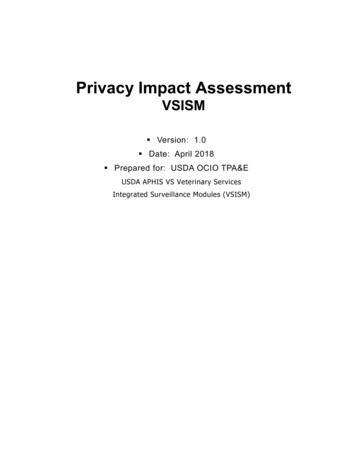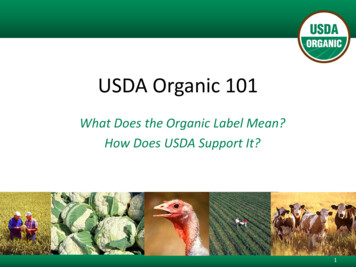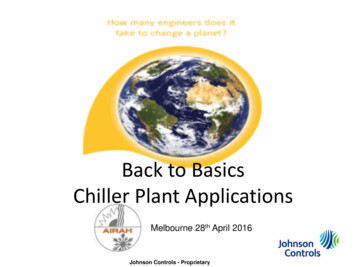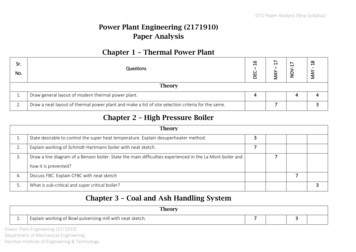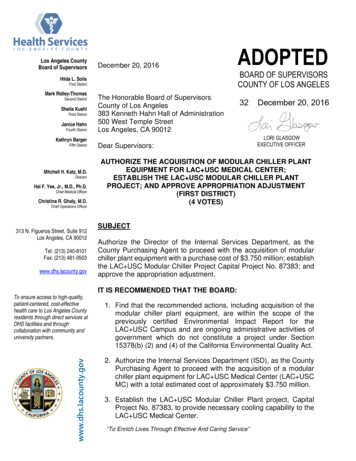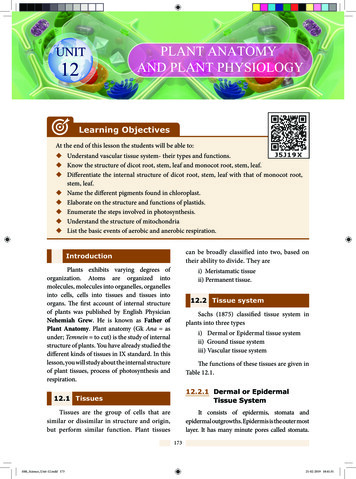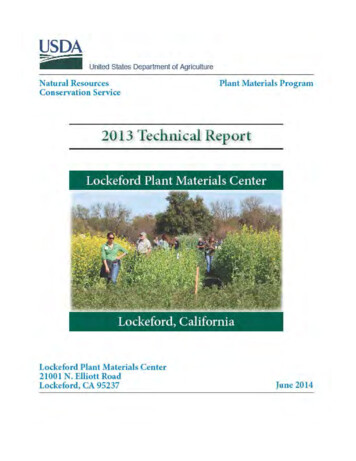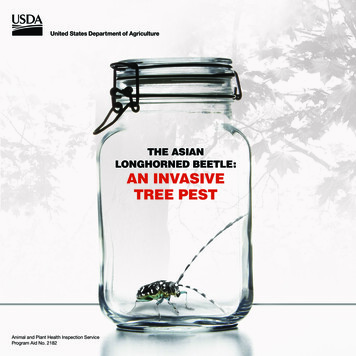
Transcription
THE ASIANLONGHORNED BEETLE:AN INVASIVETREE PESTAnimal and Plant Health Inspection ServiceProgram Aid No. 2182
In accordance with Federal civil rights law and USDA civil rights regulations and policies, the USDA, its Agencies, offices, andemployees, and institutions participating in or administering USDA programs are prohibited from discriminating based on race,color, national origin, religion, sex, gender identity (including gender expression), sexual orientation, disability, age, marital status,family/parental status, income derived from a public assistance program, political beliefs, or reprisal or retaliation for prior civilrights activity, in any program or activity conducted or funded by USDA (not all bases apply to all programs). Remedies andcomplaint filing deadlines vary by program or incident.Persons with disabilities who require alternative means of communication for program information (e.g., Braille, large print,audiotape, American Sign Language, etc.) should contact the responsible Agency or USDA’s TARGET Center at (202) 720-2600(voice and TTY) or contact USDA through the Federal Relay Service at (800) 877-8339. Additionally, program information maybe made available in languages other than English.To file a program discrimination complaint, complete the USDA Program Discrimination Complaint Form, AD-3027, found onlineat How to File a Program Discrimination Complaint omplaint-usda-customer)and at any USDA office or write a letter addressed to USDA and provide in the letter all of the information requested in the form.To request a copy of the complaint form, call (866) 632-9992. Submit your completed form or letter to USDA by: (1) mail: U.S.Department of Agriculture, Office of the Assistant Secretary for Civil Rights, 1400 Independence Avenue, SW, Washington, D.C.20250-9410; (2) fax: (202) 690-7442; or (3) email: program.intake@usda.gov.USDA is an equal opportunity provider, employer, and lender.This publication reports research involving pesticides. All uses of pesticides must be registered by appropriate State and/orFederal agencies before they can be recommended.CAUTION: Pesticides can be injurious to humans, domestic animals, desirable plants, and fish or other wildlife if they are nothandled or applied properly. Use all pesticides selectively and carefully. Follow recommended practicies for the disposal ofsurplus pesticides and pesticide containers.Issued February 2016Photo Credits: APHIS photographer R. Anson Eaglin took the photos on page 3 of the exit hole, page 4 of the adult ALB, page6 of the ground crew, and page 7 of the tree grinding and chipping work. The maple leaf photo on page 3 is from Getty Images.All other images in this brochure are USDA file photos.
THE ASIAN LONGHORNED BEETLE: AN INVASIVE TREE PESTTHE ASIAN LONGHORNED BEETLEThe Asian longhorned beetle (Anoplophora glabripennis), or ALB, isThe U.S. Department of Agriculture’s (USDA) Animal and Plantan invasive insect that feeds on a wide variety of trees in the UnitedHealth Inspection Service (APHIS) partners with Federal and StateStates, eventually killing them. If it were to become establishedagencies to find and destroy ALB infestations. APHIS and itshere, the ALB could become one of the most destructive and costlycooperators have eradicated infestations in Illinois; New Jersey;species ever to enter the country. The beetle threatens urban andManhattan, Staten Island, and Islip, NY; and Boston, MA. Eradicationsuburban shade trees, recreational resources such as parks, andefforts continue in Brooklyn and Queens, NY; on central Long Island,forest resources and wildlife. It could also harm industries such asNY; in Worcester County, MA; and in Clermont County, OH. Formaple syrup production, hardwood lumber processing, nurseries,eradication efforts to succeed, residents in infested and noninfestedand tourism.areas must remain on the lookout for this destructive pest.The ALB most likely came to the United States inside woodMEET THE BEETLEpackaging material from Asia. Nobody is sure exactly when theNative to China and the Korean Peninsula, the ALB is in thefirst beetle arrived here. Since its first discovery in Brooklyn, NY,wood-boring beetle family Cerambycidae. Adult beetles are large,in 1996, the beetle has been found in five States: New York (1996),distinctive-looking insects, measuring 1 to 1.5 inches in length withIllinois (1998), New Jersey (2002), Massachusetts (2008), and Ohiolong antennae. Their bodies are black with small white spots, and(2011). Alert workers have reported seeing it in ports and warehousestheir antennae are banded in black and white.in other parts of the country, where the insects were destroyed beforethey could escape to start new infestations.Adult females chew depressions into the bark of various hardwoodtree species. They lay an egg—about the size of a rice grain—underthe bark at each site. (Females can lay up to 90 eggs in their lifetime.)Within 2 weeks, the egg hatches, and the white larva bores into thetree, feeding on the living tissue that carries nutrients and the layerresponsible for new growth under the bark. After several weeks, thelarva tunnels into the woody tree tissue, where it continues to feedand develop over the winter. Larvae molt and can go through as manyas 13 growth phases. As the larvae feed, they form tunnels or galleriesin tree trunks and branches. Sawdust-like material, called frass, fromthe insect’s burrowing can be found at the trunk and branch bases ofinfested trees.Adult beetle tunneling in a tree3
THE ASIAN LONGHORNED BEETLE: AN INVASIVE TREE PESTTHE ASIAN LONGHORNED BEETLE: AN INVASIVE TREE PESTOver the course of a year, beetle larvae develop into adults. Thepupal stage lasts 13 to 24 days. After adult beetles emerge fromthe pupae, they chew their way out of the tree, leaving round exitholes approximately three-eighths of an inch in diameter. Once theyhave exited a tree, they feed on its leaves and bark for 10 to 14days before mating and laying eggs.Because the ALB can overwinter in multiple life stages, adults emergeat different times. This results in their feeding, mating, and laying eggsthroughout the summer and fall. While adult beetle activity is mostobvious during the summer and early fall, adults have been seenfrom April to December. Adult beetles can fly for 400 yards or more tosearch for a host tree or mate. However, they usually remain on the treefrom which they emerged, resulting in infestation by future generations.Signs of the ALB start to show about 3 to 4 years after infestation,with tree death occurring in 10 to 15 years depending on the tree’sMapleALB HOST TREESoverall health and site conditions. Infested trees do not recover, norCollectively, the tree species the insect favors are called ALBdo they regenerate. Foresters have observed ALB-related tree deathshost trees. In the United States, known ALB host trees include allin New York, Illinois, New Jersey, Massachusetts, and Ohio.species of the following 12 genera: Ash (Fraxinus) Birch (Betula) Elm (Ulmus) Golden raintree (Koelreuteria) Horsechestnut/buckeye (Aesculus) Katsura (Cercidiphyllum) London planetree/sycamore (Platanus) Maple (Acer) Mimosa (Albizia) Mountain ash (Sorbus) Poplar (Populus) Willow (Salix)In the United States, the most commonly infested tree species isExit hole on a tree4maple, followed by elm and willow.
THE ASIAN LONGHORNED BEETLE: AN INVASIVE TREE PESTBATTLING THE BEETLEAPHIS takes actions to exclude, eradicate, and/or control the ALBand other plant pests, as authorized by the Plant Protection Act of2000. The agency’s regulations for plant pests and ALB eradicationprograms can be found in title 7, sections 330 and 301.51 of theCode of Federal Regulations (CFR), respectively.To stop new ALB infestations from entering the United States, APHISregulates the import of wood packaging material, a known pathwayfor the insect’s movement. Under Title 7, section 319.40 of the CFR,all wood packaging material must be heat treated or fumigated beforebeing imported. Special stamps and paperwork must accompanyshipments to verify which approved treatment took place. Items thatFront view of an adult beetledo not meet these requirements are returned to their country of origin.To further exclude the ALB, all international passenger baggage,cargo, packages, mail, and conveyances are subject to inspectionpotential, the agency’s goal is to eliminate beetle populations in thewhen entering the country.United States. To achieve this goal, APHIS and its partners: If an ALB infestation is detected, APHIS works closely with Federaland State officials to eradicate it. Given the ALB’s destructiveestablish quarantines (up to a 1.5-mile radius from infested trees)to restrict the movement of regulated materials, inspect ALB host trees from the ground or from the air for signsof infestation, remove infested and high-risk host trees within a quarantine area, apply a preventative systemic insecticide to noninfested host trees, research best practices and eradication methods, and involve and inform the public.Before starting eradication activities, APHIS looks closely at potentialenvironmental effects. This process allows for better-informeddecisionmaking and public involvement. Over the years, extensivedata on the beetle has been collected, enabling the agency and itscooperators to refine the eradication methods used. Through years ofstudy and field examination of the ALB in all its life stages, APHIS knowsthat current methods represent the best science-based approach toeradication available to date.Infestations in North America5
THE ASIAN LONGHORNED BEETLE: AN INVASIVE TREE PESTQUARANTINESWhen ALB infestations are found, APHIS and State officials establishregulated areas (quarantines) around them. Quarantines help withbeetle eradication by restricting the movement of ALB host materials(known as regulated articles). This keeps infestations from spreadingto new locations.APHIS and State personnel inspect, or survey, host trees located nearinfested trees to identify the extent of an infestation and set quarantineboundaries. In most cases, quarantine boundaries are 1.5 miles fromtrees with ALB exit holes and half a mile from trees with only egg sites.Under quarantine, regulated articles include the beetle and all its lifestages; firewood of all hardwood species; green lumber; and otherRegulated area sign in Massachusettsliving, dead, cut, or fallen materials. Such materials include nurserystock, logs, stumps, roots, branches, and debris of one-half inch ormore in diameter of all ALB host trees.Cutting a tree into firewood does not kill any of the ALB life stages withinit. Residents should never move firewood out of an ALB quarantinearea. Instead, they should always buy firewood where it will be burned.COMPLIANCE AGREEMENTSUnder Federal and State laws, people and businesses may notmove regulated items out of an ALB quarantine area without acompliance agreement, permit, or certificate. If people or companiesdo commercial work involving regulated materials within a quarantinearea, they must enter into a compliance agreement with the ALBeradication program in their State. A compliance agreement allowsthe holder to access approved sites to dispose of woody debris.Nonetheless, even those with a compliance agreement should notmove material if they believe it may be ALB-infested. Instead, theyshould notify the eradication program right away.TREE SURVEYSAPHIS and State inspectors are always on the lookout for the ALB.They conduct year-round surveys to: find infested trees and determine the scope of an infestation; establish quarantine areas; determine whether the beetle has spread outside an establishedquarantine area and, if it has, expand the regulated area; andSection of a pallet showing tunneling and frass 6decide when to release an area from quarantine.
THE ASIAN LONGHORNED BEETLE: AN INVASIVE TREE PESTInspectors search for signs of ALB infestation on host trees by usingbinoculars from the ground, conducting aerial inspections usingbucket trucks, and climbing within tree canopies. Signs of infestationinclude egg sites, exit holes, frass, tunneling, and sap flow fromdamaged sites.If inspectors find an infestation, they conduct a Level 1 survey, alsoknown as a core survey, to determine its scope. During Level 1surveys, they look for signs of infestation on every host tree aroundthe infestation until they fail to find ALBs within approximately a halfmile radius. If they discover additional infestations, the half-mile radiusis extended from the farthest find. The half-mile radius is based on theALB’s natural spread potential.Tree climbers surveying the top of a treeTo make sure an infestation is not spreading beyond the half-mileradius established during the Level 1 survey, inspectors conducta Level 2 survey, or buffer survey. During a Level 2 survey, theyinspect host trees at least 1 mile beyond the radius set during theLevel 1 survey. Inspectors often focus on maple trees when theyare present. The eradication program may adjust the survey radiusif more infested trees are found. Level 2 surveys continue until noinfested trees are found.Federal and State personnel may also conduct a Level 3 survey, orhigh-risk site survey, to identify and inspect locations where potentiallyinfested host material may have been transported, stored, processed,or sold. High-risk sites include, but are not limited to: landscape,nursery, tree, and lawn care company locations; parks and campsites;landfills and disposal sites; and import facilities. Level 3 surveys mainlyfocus on maple trees when they are present.Inspectors typically survey a property or an area more than once.Negative survey results are required to declare an area free ofALB infestation.Ground crew inspecting a tree7
THE ASIAN LONGHORNED BEETLE: AN INVASIVE TREE PESTTREE REMOVALSControlling the spread of the ALB is vital to eradicating the beetle.All infested trees are removed, even if they have been treated withinsecticide (see “Insecticide Treatments” section on next page formore detail). A tree is considered infested if inspectors find at least oneegg site, an exit hole, or a gallery characteristic of those formed bythe ALB. Landowners are notified by mail or in person before treesare removed from their property.If host trees are near infested trees, they could harbor undetectedinfestations or be at a high risk of infestation. Due to the risk theypose, high-risk host trees within one-half mile of infested trees can beremoved with the landowner’s permission. If the landowner does notallow removal, the eradication program continues surveying. If treesA tree entering the grinding machine at a residencebecome infested, they are removed after the landowner is notified.After trees are removed, they are either incinerated or chipped toBecause the beetle can reinfest the stumps of removed trees, it isdestroy all ALB life stages within them. Trees are chipped to less thangood to remove and grind them. In some locations, stumps are left1 inch in two dimensions to remove the risk of ALB. Wood chips ofto allow for regrowth, particularly in areas prone to soil erosion orthis size are no longer a regulated article.in sensitive wildlife habitats. The eradication program may also useherbicides to prevent shoots from growing out of stumps.When trees are removed from yards and landscaped settings, theeradication program may restore the area by grading and plantinggroundcover. This reduces the likelihood that invasive weeds willbecome established and helps hold the soil in place.TREE REPLANTINGFederal and State personnel work with various organizations to replantnonhost trees in areas where trees are removed as part of the ALBeradication efforts. The goal is to help preserve the tree canopy lost,ensure diversity of tree species, and reinvigorate neighborhoodsand streetscapes. Replanting programs vary by State, but affectedresidents may be eligible for tree replanting at no cost to them.8Material being ground into chips at a disposal yard
THE ASIAN LONGHORNED BEETLE: AN INVASIVE TREE PESTINSECTICIDE TREATMENTSControl efforts can include treating noninfested host trees in quarantineareas with the insecticide Imidacloprid. This treatment reduces beetlepopulations and can prevent trees from becoming infested.When determining whether to treat trees with Imidacloprid, APHISand State officials consider several important factors, such asefficacy, environmental and biological issues, the scale of aninfestation, and cost. They must ensure that specific criteria are metbefore applying the insecticide. High-risk host trees within one-halfmile of an infested tree can be treated with the landowner’s permission.If the landowner does not allow the treatment, survey efforts continue.If trees later become infested with ALBs, they are removed after theDirect soil injectionlandowner is notified.Imidacloprid treatments can be effective against ALBs when appliedin the spring, early summer, or fall—prior to or when adults emerge.the tree, depending on the tree’s size and condition and weatherImidacloprid is injected directly into the tree’s trunk or into soil atcircumstances. For maximum effectiveness, trees should be treatedthe tree’s base. It takes 1 to 3 weeks by trunk injection and up toannually for 3 consecutive years.3 months by soil injection for Imidacloprid to distribute throughoutWhile Imidacloprid treatments can decrease beetle populations andhelp protect against future tree loss, they do not completely controlALB spread.RESEARCHResearch is conducted in laboratories across USDA to learn moreabout the ALB. This information, in turn, guides the eradicationmethods that APHIS and State cooperators develop and carry out.U.S. scientists have traveled to China to learn more about the insect.But, even in Asia, little scientific information was available in 1996,when the beetle was first detected in the United States. Field studiesand trials and laboratory research over the years have been vital indeveloping the protocols used today to fight the beetle.Direct trunk injection9
THE ASIAN LONGHORNED BEETLE: AN INVASIVE TREE PESTUSDA is now researching regulatory treatments for wood and nurserystock, chip size and grinding techniques to deregulate ALB hostmaterials, traps to lure adult beetles, and the use of dogs to detect theinsect’s presence. USDA is also studying how quickly the insect spreadson its own and its host tree preference and range. In addition, USDA isconducting DNA analysis and various behavioral experiments.OUTREACH AND EDUCATIONAPHIS and its partners recognize the importance of publicinvolvement and outreach. They strive to share as much informationas possible with people who live and work in ALB-affected areas. Analert Brooklyn homeowner was the first to notice beetle damage onhis trees and report it to authorities, leading to the discovery of thisinvasive pest in the United States. Since then, residents have helpedTable at an outreach eventuncover infestations in other areas of New York and in Illinois, NewJersey, Massachusetts, and Ohio. In addition to detection, informedresidents understand the importance of giving program officialsERADICATIONaccess to their property so that they can search for signs of theTo declare eradication in an area, APHIS and State officials requirepest, apply treatments, and remove infested trees, if needed, beforea final round of negative survey results. A final survey cycle isan infestation spreads to other areas.completed at least 4 years after an initial ALB detection. The exacttiming depends on several factors, including the size and scope of theoriginal infestation and other programmatic and logistical aspects.AFFECTED STATESAPHIS and State personnel are now fighting ALB infestations in threeStates: New York, Massachusetts, and Ohio. Information about theeradication program operating in each State is below.If you perform work on regulated articles in any quarantine area, youmust enter into a compliance agreement with the ALB eradicationprogram in your State to move items to approved sites for disposal.Before entering into an agreement, you need to attend freecompliance training. To register for this training, please call:10Checking a tree trap 631-288-1751 if you work in New York. 508-852-8110 if you work in Massachusetts. 513-381-7180 if you work in Ohio.
THE ASIAN LONGHORNED BEETLE: AN INVASIVE TREE PESTNEW YORK PROGRAMThe ALB was discovered infesting trees in Brooklyn, NY, in August1996. Since then, it has been detected in other areas of the State. Toachieve ALB eradication in New York, APHIS partners with the NewYork State Department of Agriculture and Markets (NYSDAM).Currently, 137 square miles are regulated for ALB in the State,including the New York City boroughs of Brooklyn and Queens andpart of central Long Island. APHIS and NYSDAM have eradicatedinfestations in Manhattan, Staten Island, and Islip.For questions about the New York ALB Eradication Program,call 1-866-265-0301.Asian Longhorned Beetle Eradication ProgramUnited StatesDepartment ofAgricultureNew York Overview 2014WestchesterBronxCrossManhattannx Expy!! ! ! ! !! ! ! ! ! ! ! ! ! ! ! ! ! ! ! !! ! ! ! ! !! ! ! !! !! !!! !! ! ! ! ! ! !! ! ! ! ! ! ! ! !! ! ! ! ! ! ! ! ! ! ! ! ! ! ! ! ! ! ! ! ! ! ! ! ! ! ! ! ! ! ! ! ! ! ! ! ! ! !! !! !! ! !! ! ! ! ! ! ! ! ! ! ! ! ! !! ! ! ! ! ! ! ! ! ! ! !! ! ! !! ! ! ! ! ! ! ! ! ! !! !!! ! ! !! !! ! ! !! ! ! ! ! ! ! ! !! ! ! ! ! !! ! ! ! ! ! ! ! ! ! ! ! ! ! ! ! ! ! ! ! ! ! ! ! ! ! ! ! ! ! !! ! ! ! ! ! ! ! ! !! !! ! !! ! ! ! ! ! ! ! ! ! ! ! !! ! ! ! ! ! ! ! ! ! ! ! ! ! ! ! ! ! ! ! ! ! ! ! ! ! ! !! !! !! ! !! ! ! !! ! ! ! ! ! ! ! ! ! ! !! !! ! ! ! ! ! ! ! ! ! ! ! ! ! ! ! ! ! ! ! ! ! ! ! ! ! ! ! ! ! ! ! ! ! ! ! ! ! ! ! ! ! ! !! ! ! ! ! ! ! ! ! ! ! ! ! ! ! ! ! ! !! !! ! ! !! ! !! ! ! ! ! ! ! ! ! ! ! ! ! ! ! ! !! ! ! ! ! ! ! ! ! ! ! ! ! ! ! ! ! ! ! ! ! ! ! ! ! !! ! ! ! ! ! ! ! ! ! ! !! ! ! ! ! ! ! ! ! ! ! ! ! ! ! ! ! ! ! ! ! ! ! ! ! ! ! ! ! ! ! ! ! ! ! ! ! ! ! ! ! ! !! !! !! ! ! ! ! ! !! !! ! !! ! ! ! ! ! ! ! ! !! ! ! ! ! !! ! ! ! ! !! !! ! ! ! ! ! ! !! ! ! ! ! ! ! ! ! ! ! ! ! ! ! ! ! ! ! ! !! ! ! ! ! ! ! ! ! ! !! ! ! ! ! !! ! ! ! !! ! ! ! ! ! !! ! !! ! ! ! ! ! ! ! ! ! !! ! ! ! ! !! ! ! ! ! ! ! ! ! !! !! ! ! ! ! ! !! ! ! ! !! ! ! !! ! !! ! ! ! ! ! !! ! !! !! ! ! !! !! ! ! ! ! !! ! ! ! ! ! ! !! ! !! ! !! ! !! ! ! ! ! ! !! ! ! ! ! !! New Jersey !! !!! !! ! ! ! ! ! !! ! ! ! ! ! ! ! ! ! ! ! ! ! ! ! ! ! ! ! ! ! ! ! ! ! ! ! ! ! ! ! ! ! ! ! ! ! ! ! ! ! ! ! !ngLoIslanxpydECentral Long IslandNassau !!! ! ! ! ! ! !Islip! ! ! ! ! ! ! ! ! ! ! ! ! ! ! ! ! ! ! ! ! ! ! ! ! ! ! ! ! ! ! ! ! ! ! ! ! !! ! ! ! ! ! ! ! ! ! !! ! ! ! ! ! ! ! ! ! ! ! ! ! ! ! ! ! ! ! ! ! ! ! ! ! ! ! ! ! ! !! ! ! ! ! ! ! ! ! ! ! ! ! ! ! ! ! ! ! ! ! ! ! ! ! ! ! ! ! ! ! ! ! ! ! ! ! ! ! ! ! ! ! ! ! ! ! ! ! ! ! ! ! ! ! ! ! ! ! ! ! ! ! ! ! ! ! !! ! ! ! ! ! ! ! ! ! ! !! ! ! ! ! ! ! !! ! ! ! ! ! ! ! ! ! ! ! ! ! ! ! ! ! ! ! ! ! ! ! ! ! !! ! ! ! ! ! ! ! ! !! !! ! ! ! ! ! ! ! !! ! ! ! !! !QueenslBeKings! ! ! !! ! ! ! !RichmondVerran zanoBrgtwPkyEradicated:August 2011 ! ! ! ! ! ! ! ! !!! ! !! !! BrooklynLegendStatenIslandEradicated:May 2013 Suffolk4204 MilesDISCL AIM ER: T hese d ata, and all th e in fo rmatio n con tained therein ,have b een collected by the U .S. Dep artmen t o f A gricu ltu re's A nimalan d Plan t H ealth Ins pection Service (APHIS), o r by its coo perators onAPHIS’ b eh alf, fo r res tricted g overn men t p urpo ses o nly and is th e so leprop erty o f A PH IS. Data may be diss eminated on a need-to-kn owbasis o nly and mu st be u sed fo r th eir in tend ed g overnment pu rpos e(s).All in formatio n con tained w ithin th ese data are sub ject to req uiredFed eral safegu ard s an d s hall on ly be sh ared and /or u sedco ns istent with the Trade Secrets Act [18 U.S.C. 1 90 5], the Priv acyAct o f 197 4, as amended [5 U. S.C. 55 2a], the Freed om o fIn formatio n Act [5 U. S. C. 55 2], the con fiden tiality p ro visio ns of theFo od Secu rity A ct o f 198 5 [7 U.S.C. 2 27 6], Section 161 9 o f theFo od, Cons ervation, and Energy A ct of 200 8 [7 U.S.C. 8 791 ], andoth er ap plicable Fed eral law s and imp lementing reg ulatio ns , as w ellas with the co nfid entiality or no n-disclosu re prov ision s o f any o th erag reement entered in to betw een A PHIS and a coop erator.Bas e data p rovided by: NY C DOITT Office of GIS, & TeleAtlas.Ackno wled gement: Th e New Yo rk State Departmen t o f A gricultu re & Mark ets,The N ew York State D epartment of E nvironmental Co nserv atio n,an d Th e New York City Department of Park s & Recreatio n. !Infested Trees (2013-2014)Infested Trees (historical)Regulated Boundaries (Active)Previously Regulated AreaMajor RoadsNYC Boroughs or County BoundariesPPQ- GISManhattanEradicated:May 2013B roNew YorkUSDA - APHIS - PPQ - ALB, 2014Map of regulated areas in New York11
THE ASIAN LONGHORNED BEETLE: AN INVASIVE TREE PESTMASSACHUSETTS PROGRAMThe beetle was first found in Worcester, MA, in August 2008.STERLINGPRINCETON12CLINTON11062Since that time, the regulated area has expanded within Worcester70County due to additional detections. APHIS and the Massachusetts1401906231Department of Conservation and Recreation (DCR) work together onnaningSt110MWachusettReservoirALB eradication efforts in the State.BERLIN70Wachusett StHOLDENWEST BOYLSTONAt present, 110 square miles are regulated for the ALB in Worcester122AHighlandStCounty. Regulated areas include all of Worcester, West Boylston,MaiBoylston, and Shrewsbury, as well as part of Holden and Auburn.t140ileyBa70ChaAPHIS and DCR have eradicated the beetle in 90290140PAXTONHill RdStonehouseFor more information about the Massachusetts ALB EradicationProgram, call 2209WORCESTER290122 llbury140122St146122A2090Regulated AreaLakes and PondsTown BoundaryInterstateU.S. HighwayState RouteNon-numbered routeRegulated Area to Suppress and Control the Asian Longhorned BeetleOctober 17, 201100.51 MileGeographic data supplied by the Office of Geographic Information (MassGIS) and DCR GIS.Map of the Worcester County, MA, regulated area12
THE ASIAN LONGHORNED BEETLE: AN INVASIVE TREE PESTRDYKESMODER RDSTDANNA BVRDDRNERLN4RAMD SR32N O5GR ANT «DSL A DOLGERDRDPGR IMESRIR ESR 32CO BBRDRDONENRIG REIAR IDCKBRAKRDKP ARMT HOLLY LNMITLIcall 513-381-7180.HMSR 132BataviaELJUDD RD276SUCL OHUGSRLD RDRONPIBatavia Townships.HEPIMCES ONKEEVRUEBAJA CKSSKLNLLOLD S R 74RDRKHAR RDERDFISL AGTO222A RPS CUTOFF RDRIGGSLNHAWLE YRD «ROSState of OhioOverviewJackson!!((!(infestations in the State. Currently, 61 square miles are regulatedRDAB ER RDONNTpartners with the Ohio Department of Agriculture to eradicate (!(!( !!(!(!((!(!(!((!((!((!!(!(!((!(!((!(!(!( (!(!(!!(!( !!(!(!(!( !!(!(!!(!(!(!!((!(!(!(!( !!(!((!(!!(!(!(!(!(!(!(!!( (!!(!(!(!(!( ( !((!((!(((!(!(!((!(!(((( !!(((!!(!(!(!!(( !(!(!(!(!(!!((!(!(!((!(!( !!(!( !!(!(!!(!!(!(!!((!(!(!(!((!( !(!((!(!(!(!(!(!(!!(!!((!(!(!(!(((!(!( (!(!( !!(!((!((!(!(!(!(!(!(!!( !(!(!(!(!(!((!!((!(!( !!((!!(!(!(!(!((!(!(!(!( !(!((!(!( !!(!(!((!(!(!(!!((!(!(!( !!((!(!(!(!(!(!(!!(!(!(!( !!(!(!(!(!( !!(!(!( (!!(!!(!(!(!(!(!(!!(!(( !(!(!(!(((!(!(!(!!(!!( !(!(!(!(!(!(( !!(!(!(!((!((!(!!(!(!!(!(!(!(!!((!(!((!(!((!(!( (!!(!((!!(!(!(!(!!(!(( !(!!!((!(!((!(!((!((!!(!!(!(!(!(!(!!(!(!(!( !(!( ((!(!((!((!(!(!(!!(!(!(!(!(!(!!(( !!(!(!(( !!(!(!(!(!(!(!(!(!(!((!((!(!(!(!(!(!(!(!(!(!( !!(!(!(!(!(!(!(!(!(!(!(!(!(((!((!(!(!(!(!(!(!(!( (!(!!((!(!!(!(!(!(!(!(!(!(!( !(!(!(!((!(!(!(!(!(!(!(!(!(!(!(!(!(!(!(!!( !((!( !!((!((!(!!( !!(!((!(!(!(!!((!!(!(!(!(!!(!(!(!(!!((!(!( !(!( !(!( !((!((!(!(!(!!(!(!(!(!(!(!(!(!(!(!(!(!( !!(!(!!( !(!!(!(!(!(!((!(( !!(!(!(!(!!(!( !(!(!!( !!(!!(!(!( (!(!(!(!(!(!( !(!(((!(!(!(!(!(!(!(!(!( (!(!(!(!(!(!(!(!(!( !((!!( !((!(!(!(!(!( !!(!(!( !(!( !!(!(!(!(!(!(!(!(!(!(!(!(!( !(!(!(!(!( (!!(!(!(!(!(!(!(!(!(!(!(!((!(!(!(!(!(!(!(!((!(!( !(!!(!(!(!(!(!(!(!(!((!(!((!(!(!(!(!(!(!( !!(!(!(!(!(!(!(!((!(!(!(!(( !!(!(!(!(!(!(!(!(!(!(!(!(!(!(!((!(!(!(!(!!( !(!((!(!(!(!(!(!(!(!!(!(!!((!(!(!(!(!( (!(!(!(!(!(!(!!(((!(!(( !!(!((!(!(!(!(!(!(!(!(!(!(!(!(!(!(!(!((!(!(!( (!(((!(!(!(!(!(!(!!((!(!(!( (!(!!(!(!(!(!!(!!(!(!(!(!(!(!(
Animal and Plant Health Inspection Service Program Aid No. 2182. In accordance with Federal civil rights law and USDA civil rights regulations and policies, the USDA, its Agencies, offices, and employees, and institutions participating in or administering USDA p

